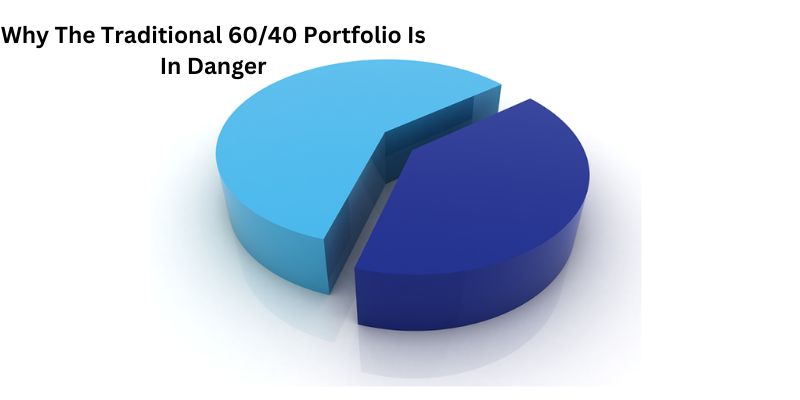Why The Traditional 60/40 Portfolio Is In Danger
Triston Martin
Oct 25, 2023
In times of economic instability and ever-changing markets, investors are looking for a way to protect their portfolios from potential losses due to volatility. For years, the traditional 60/40 portfolio has been held up as a reliable option for those wishing to minimize risk while still maintaining steady returns.
However, recent developments have shown that relying solely on this approach may no longer be enough to guarantee reliable growth in an uncertain fiscal climate. We'll examine why the traditional 60/40 portfolio is threatened and provide alternative approaches that could prove more resourceful in these turbulent times.
What is the Traditional 60/40 Portfolio and Why Has it Been Favored for so Long

The traditional 60/40 portfolio is a balance of investments used since the 1960s. It comprises 60 percent stocks and 40 percent bonds, providing investors with a balance between risk and reward. Historically, it has been favored by conservative investors due to its low volatility and steady returns over time.
Furthermore, it was seen as a great way to diversify one's holdings while shielding against any losses that might be incurred with more volatile investments. However, recent events have made this approach less reliable for many investors.
Why is the traditional 60/40 portfolio in danger?

The traditional 60/40 portfolio is at risk primarily due to increasing economic uncertainty, which has caused a great deal of market volatility. The global markets have become much more unpredictable in recent years, making it difficult to accurately predict or recover from losses.
Traditional bonds have seen lower returns than stocks due to rising interest rates and inflation, which has decreased the purchasing power of these investments. This reduced reliability of the traditional 60/40 portfolio has led many investors to look for other options to better protect their portfolios while still providing steady growth.
Several alternative approaches could provide greater security and stability for those looking for a reliable investment strategy in times of uncertainty. These include diversifying into different asset classes, such as real estate or commodities, and exploring alternative investment vehicles, such as ETFs (exchange-traded funds).
By investing in various assets, investors can reduce exposure to risk while still achieving steady growth. Furthermore, these alternative investments may provide more diversification and downside protection than the traditional 60/40 portfolio.
The 60/40 Portfolio's Critical Flaw
The critical flaw of the traditional 60/40 portfolio lies in its lack of flexibility. As markets become more unpredictable, investors must be prepared to adjust their holdings accordingly. A static allocation, such as the traditional 60/40, may need to be equipped to handle sudden market changes or prolonged economic downturns. Furthermore, this approach needs to consider other factors, such as inflation and taxes, which can further reduce returns in times of volatility.
Ultimately, while the traditional 60/40 portfolio is still reliable for many investors, it may need more stability in an ever-changing economic landscape. For those seeking greater financial security, alternative approaches could offer a better balance between risk and reward in times of uncertainty. By diversifying one's portfolio and exploring different asset classes, investors can ensure that their investments remain resilient during volatile times.
As global markets become more unpredictable, investors must stay informed and be prepared to adjust according to changing conditions. The traditional 60/40 portfolio may no longer provide the protection necessary for success in these uncertain times.
Alternative approaches should be explored to protect one's financial security while still achieving steady returns. 's portfolio and investing in various asset classes, investors can ensure that their portfolios can withstand market fluctuations while still providing steady returns.
Every investor needs to assess their financial needs and risk tolerance before making investment decisions. Knowing what type of investments one should make and when is key to achieving growth over time, regardless of market conditions.
By understanding how the traditional 60/40 portfolio may not be enough to protect your investments and exploring alternative approaches, you can better prepare yourself for potential losses while still striving towards long-term goals. Investing can be intimidating, but with the right strategy, you can feel more secure about your financial future.
Geopolitical Factors Contributing to the Decline of the 60/40 Portfolio
The traditional 60/40 portfolio faces increasing pressure from various sources, notably geopolitical events that can drastically alter global markets. In recent years, the world has seen numerous trade wars, currency devaluations, and other international conflicts that have caused shockwaves in financial markets.
As these events occur more frequently, it has become increasingly difficult for investors to accurately predict or minimize losses associated with extreme volatility.
Furthermore, geopolitical factors such as government sanctions and regulations can limit investments in certain countries. This can make it harder for investors to diversify their holdings, further reducing returns when economic uncertainty strikes.
Tips for creating a more diversified portfolio for investors moving forward
- Diversify across different asset classes: Investing in multiple asset classes such as stocks, bonds, real estate, and commodities can provide investors with greater diversification and help reduce the risk of volatility-related losses.
- Consider investing in alternative investments: Exploring alternative investment vehicles such as ETFs (exchange-traded funds) or mutual funds can provide additional diversification and may offer the potential for higher returns compared to traditional investments alone.
- Monitor your portfolio regularly: As markets become more unpredictable, monitoring your investments closely and adjusting your holdings accordingly is importantz. Regularly reviewing your portfolio will ensure that you are up to date with any changes in market conditions that could affect your investments.
- Consider the geopolitical landscape: Attention to international news and government policies to understand how global events may impact your investments. Knowing potential geopolitical risks can help you better prepare for potential losses due to market volatility.
By understanding the critical flaws of the traditional 60/40 portfolio and exploring alternative approaches, investors can ensure that their portfolios remain resilient during times of economic uncertainty.
FAQS
Is a 60-40 portfolio aggressive?
The 60/40 portfolio is considered a moderate-risk allocation as it typically has less volatility than an all-equity portfolio. This type of portfolio generally provides investors with steady returns while offering some protection in downturns.
What is the downside of the commonly used 60-40 portfolios in asset wealth management?
The main downside of the traditional 60/40 portfolio is its need for more flexibility. As markets become more unpredictable, a static allocation such as the traditional 60/40 may not be able to handle sudden market changes or prolonged economic downturns.
Are 60-40 portfolios facing the worst returns in 100 years?
The 60/40 portfolio has faced some of its worst returns in the last 100 years due to increased market volatility. As global markets become more unpredictable, static allocations such as the traditional 60/40 may no longer provide enough stability for investors.
Conclusion
All investors are searching for the perfect retirement portfolio, but in today's economic climate, there are increased risks to consider that a traditional 60/40 investment strategy may no longer provide the security and returns retirees need. It is important to keep up to date with current market trends and have a financial plan that can account for the changing conditions of our economy. Establishing realistic goals is critical as market downturns happen; it is crucial to remain diversified and adjust investments quickly.







